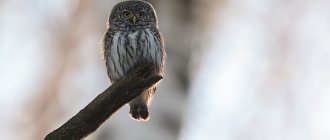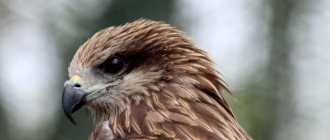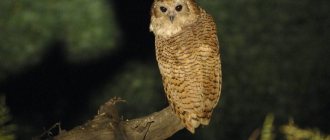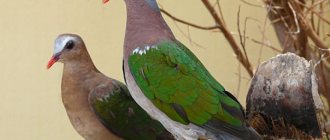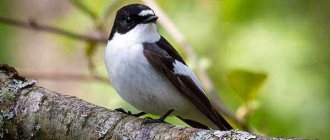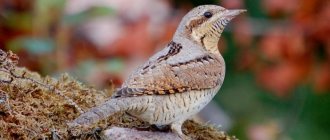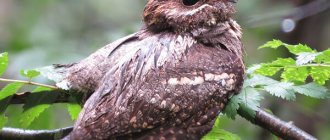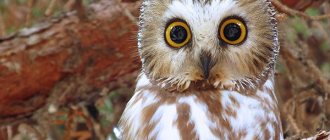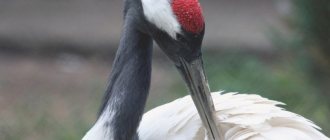Owls are small-sized birds belonging to the order Owls. The Latin name of the bird is “Athene”, so the bird has a (naturally mythical) connection with the ancient Greek goddess of war and wisdom, Pallas Athena. These birds, along with the snakes that became the companions of the warlike daughter of Zeus, are present in the paintings and sculptures of many famous artists and sculptors. If we talk about Russia, here these birds were considered harbingers of various troubles and misfortunes, so a chance encounter with an owl was considered very bad.
Origin of the species and description
Photo: Little Owl
The little owl is a representative of a small genus of owls from the owl family. Birds of this family usually live in open areas, do not like frequent flights and are nocturnal. Owls vary in size, but are generally small birds that feed primarily on insects.
Video: Little Owl
In addition to the little owl, the genus of owls includes the following two species:
- The Brahmin's owl is an inhabitant of Asia and Iran. He is in constant cooperation with people in small settlements, as he destroys harmful insects that could cause nuisance in agricultural fields. This is the most common species of the genus of owls;
- rabbit owl (rabbit owl, cave owl). It lives only in North America, inhabiting fields and meadows. It got its name not because the bird feeds on rabbits - the size of this owl is very small, so rabbit owls eat insects. The short owl digs holes and lives there, which is how it gets its name.
The little owl is also a common representative of the genus. It is difficult to say when these three species split into several evolutionary branches. What is reliably known is that their difference lies, first of all, in different habitats and, consequently, in different eating and behavioral habits. The little owl differs in many ways from its closest relatives.
How an owl screams
The voice of an owl is difficult to confuse with anything. These are plaintive and piercing sounds heard in the night. Therefore, since ancient times, people have been wary of the calls of the owl. It was believed that hearing an owl meant all sorts of misfortunes and troubles.
A hissing note can be clearly heard in the owl's calls. After all, the owl got its name in Russia because of the sounds it makes. The verb “sychet” is still used in some regions. This is what they say about a person who hisses angrily.
How the little owl screams, watch the video
Appearance and features
Photo: What does a little owl look like?
Little owls are twice as small as a common owl. Their body length is only about 25 cm, from the crown to the tip of the tail, of which the tail is about 7-9 cm long. This small bird weighs about 170 grams, and the smallest individuals can weigh less than 150. Although at home the little owl can fatten up to three hundred grams.
Interesting fact: The little owl differs from other owls in that it does not have protruding feathers on its head that resemble ears.
The feather color is brown with various gray shades. From head to back, the little owl is covered with white specks and longitudinal white stripes, which seem to visually elongate the bird. The house owl's head is small, with a very mobile neck - like all owls. The head has a round, slightly flattened shape. The eyes are very large, bright yellow, with a black round pupil. The beak of the little owl is small, yellow or brown. The body shape is streamlined, which allows the owl to fly quickly and easily maneuver between obstacles - the head smoothly flows into the body, and the transition is smoothed out by feathers.
Interesting fact: Like all owls, owls cannot move their eyes, so they turn their necks - up to 180 degrees - to gain a wide view.
The wings of the little owl also fit tightly to the body, but they are quite short - about 15 cm in length, so they do not reach the tip of the tail. The tail is also small and wide. Due to their thick feather cover, owls appear to be plump birds, but in reality they are very thin.
The owl has thin short legs that are covered with feathers almost to the claws. The claws are long, strong, allowing the attack to grab small prey.
Where does the little owl live?
Photo: Little owl in Russia
The little owl is a very common bird that has taken root in different places and in different climates. It lives everywhere except the North and South Poles, tropical regions and the far north. It can be found throughout Europe, including in the European part of Russia. The little owl has comfortably taken root in Asia, North and South America, where it conflicts with other species of owls, fighting for food supply. Africa can also be called its habitat.
Like all types of owls, the little owl avoids mountainous areas, lowlands, forests and too wet climates. This is due to the fact that the little owl needs a lot of space for the maneuvers it makes during the hunt. He also does not like regions where the soil is covered with a thick layer of snow - his short paws cannot snatch prey from under it.
The little owl is called this way largely because it likes to settle near villages and small towns, setting up its nests directly in buildings or under roofs. Attics, abandoned buildings and even cemeteries with their tall monuments are also suitable habitats.
Interesting fact: Due to the fact that owls love to settle in cemeteries, people have long considered these birds to be evil spirits and messengers of evil.
Also, the little owl settles comfortably at home. It cannot be kept in a cage or aviary, so breeders provide the owl with a whole room with several elevations so that the bird feels comfortable.
Now you know where the little owl lives. Let's see what he eats.
Owl bird: description
The classification of these birds implies the existence in the natural environment of 2 to 5 varieties. Nowadays, experts are more inclined to believe that owls represent only 3 species - Brahmin, Brown and Rabbit. The forest owl, which was previously part of them, has been separated into a separate genus.
Appearance
Owls are not large birds, since their body length does not exceed 30 centimeters and their weight does not exceed 200 grams. The wingspan of these birds barely reaches 0.6 meters. Based on their appearance, we can say that owls are chicks of owls, since they have similarities, but adult owls are significantly larger than owls in size. It should be noted that the owl's head is almost round, while the owl's is somewhat flattened, and the facial disc is not as pronounced as that of the owl. Owls also differ from owls in that they do not have feathers growing on their heads, which form something like ears.
The tail of owls is relatively short, as are the wings, especially if they are folded. These birds have fairly dense plumage, colored in brownish or sandy tones, with small whitish spots scattered throughout the body in a chaotic manner. Above the eyes, the eyebrows are brightly highlighted in white. The belly area is lighter, diluted with basic, darker tones.
The claws are relatively long and quite sharp. Their color is blackish-brown, and the beak of owls is yellowish with an admixture of light green and gray shades, while the beak may have a darker color compared to the underbeak. The eyes are bright, with a black pupil that stands out in contrast. The iris of the eyes is colored depending on the species of the bird, so it can have a light yellow tint, yellowish-golden, etc.
Interesting fact! Owls have a characteristic sullen look, while it is also prickly and piercing. Most likely, it is his gaze that is associated with various negative statements of a person, as well as a negative reaction with the appearance of negative thoughts.
First of all, this concerns Rus', since it was there that the owls received such negative reviews about themselves.
House owl - voice | Film Studio Aves
Character and lifestyle
Owls prefer to lead a sedentary lifestyle, and their activity occurs at night. Although these birds migrate over short distances, they are only forced to do so, but mostly they settle in a certain territory and do not leave it for years. Like owls, owls have excellent vision and hearing, especially at night. This allows them to perfectly navigate the night forest, and also simplifies hunting conditions. Owls fly so silently that a potential victim may only sense danger in the last seconds, although this does not save it.
Interesting to know! Owls cannot turn their eyes, so they often turn their heads to assess the living space around them. Due to the fact that this bird’s neck is flexible, it manages to turn its head almost 270 degrees.
Owls mainly hunt in complete darkness, although there are species that hunt during the day. Owls are quite cautious birds, so getting close to them is not so easy. If the owl did not have time to react to the appearance of a person, then he tries to scare the person away, bowing and swaying from side to side. Such bird movements are more reminiscent of some kind of comical dance. Very few people managed to watch this dance.
When such movements do not help get rid of the danger, the owl takes off and flies away, hovering low above the ground. During the daytime, owls rest by climbing into one of the hollows or hiding in crevices between rocks. These birds can arrange nests on their own, or they can take over someone’s nest if no one lives in it. As a rule, owls live in the same nests for many years, unless something unexpected forces the bird to leave its home and go in search of a new one.
How long do owls live?
Living in the wild, these birds live for about 15 years, which, as for birds, is quite a lot.
Sexual dimorphism
Males, compared to females, are practically no different, so it is not easy to distinguish them, especially since even their sizes are the same, although females are somewhat larger, but this is not visually noticeable. Only during breeding periods is it possible to find out who is who by the behavior of birds.
Types of owls
Nowadays, scientists have identified owls into 3 species, such as:
- Brahmin owls.
- Little owls.
- Rabbit owls.
In fact, there were many species of such birds, and most species disappeared from the face of the earth in the Pleistocene. The Cretan and Antiguan burrowing owls have been unlucky closer to our time due to the fact that humans have deprived these birds of their natural habitats.
Brahmin Owl (Athene brama)
They are characterized by small (comparatively) sizes, since their body length is slightly more than two tens of centimeters, and their weight is within 120 grams. The main color of the plumage is gray-brownish, diluted with white in the form of dots. The belly area, on the contrary, has an almost white color, with the presence of dark-colored dots. The neck area, as well as the lower part of the head, has something similar to a white “collar”. The voice set is quite original, as it consists of alternating sounds similar to grinding. The habitat of this species is associated with vast territories of Southeast and South Asia, as well as with the territory of Iran.
Little Owl (Athene noctua)
In size, this type of owl is slightly larger than the previous one, since its body length reaches 25 centimeters and its weight is within 170 grams. The main color of the bird's plumage is light brown or sandy, with the presence of white feathers.
Interesting information! This species of bird got its name because it can settle in a person’s home, taking a liking to the attic of a house or barn. These birds are not afraid of humans and can become tame, so they are often kept as pets.
The habitat of little owls is quite extensive and includes the territories of Southern and Central Europe, the northern territories of the African continent, as well as most of Asia.
Bathing the Little Owl Yuini. The owl takes a shower and buzzes a little at the cat.
Rabbit owl (Athene cunicularia)
This species can be active not only at night, but also during the daytime, but if it is very hot, these owls prefer to be in the shade. The main plumage of the species is reddish-brown, with the presence of gray shades, as well as the presence of white streaks. The chest area and upper belly are grayish-brown, with inclusions of yellow tones. The belly area is whitish-yellow, without any inclusions of other colors. The body length is also small and is within 23 centimeters. These birds live in the vast expanses of North and South America, preferring open spaces. They use the burrows of rabbits and other rodents as their nests.
Where do they live?
Owls live in vast areas of the Eurasian continent, in certain areas of the African continent, as well as in the New World. These birds can be found both in open spaces and in forests, in mountainous areas, in deserts and semi-deserts.
Brahmin owls
This species lives preferably in South Asia, choosing open spaces or open forests with the presence of shrub vegetation for its life activities. Often these birds can be found near human habitation. For example, many owls live in the suburbs of Delhi or Kolkata. As a rule, Brahmin's owls nest in hollow trees, although they easily take up residence in abandoned buildings, such as abandoned palaces. If on their way they come across a nest abandoned by other birds, for example, mynah starlings, then they will settle in it.
Little owls
These birds can easily be found in vast areas of Central and Southern Europe, almost throughout Asia, as well as in the northern regions of Africa. Basically they prefer to equip their nests in various buildings. Living in the wild, little owls prefer to live in open spaces, while they are found in deserts and semi-deserts. As shelters for the nest, they choose various natural shelters in the form of burrows, tree hollows, root systems, in stone deposits, etc.
Where do Little Owls live in the wild? Subtitles! Little owls in the wild.
Rabbit owls
These birds are also called cave owls. Their habitat extends to South and North America. They prefer open areas with low shrub vegetation. They make their nests in the burrows of rabbits and other large rodents. Birds rest in these same shelters to escape the heat of the day.
What does it eat?
Owls represent the category of birds of prey, so their diet consists of animal food. As a rule, owls hunt in pairs, so they can easily defeat even gray rats, although it is extremely difficult for owls to obtain such a trophy alone. Alone, they can hunt other, less dangerous animals.
Interesting moment! These birds, which have been engaged in underground hunting of voles for many years, are not difficult to identify at first glance. Their feathers on the head, as well as on the upper part of the body (on the back), are combed so much that instead of them only the skeletons of feathers remain, indicating that there was also plumage here before.
Basically, the diet of owls depends on the species and can vary significantly. Some owls hunt voles, other owls eagerly eat dung beetles, and still others hunt spiders, and large ones at that. In addition to their favorite food items, the diet of owls includes many other species of animals, small birds, amphibians, etc.
In order to never remain hungry, owls prefer to store food for future use. Rabbit owls are distinguished by the fact that they bring the dung of certain animals to their nests in order to lure dung beetles into their burrow, which serve as a favorite delicacy for them.
Reproduction and offspring
Owls are different in that. That their breeding process begins in the month of February. It is in winter that they begin to look for a mate for themselves, thinking about procreation. Males, emitting loud cries, attract females to themselves. If the couple has formed, then the male and female begin the process of mutual courtship. They feed each other, stroke each other, lightly pinching each other with their beaks.
After fertilization, the birds begin to build a nest, after which the female lays eggs. After the first egg is laid, the female immediately sits on the nest, beginning the incubation process. This is why owls have offspring with a large time difference. And for the same reason, out of 5 eggs laid, only a couple of chicks can survive, although these birds cannot be called bad parents.
Important point! The eggs are mainly incubated by the female, although she sometimes leaves her nest. When the female sits on the eggs, the male feeds her, and when she leaves the nest, the male sits on the eggs instead. The responsibilities of the male also include protecting the nest and the female from attacks by other predators.
Fledged young owls remain in the parent's nest for several more weeks to learn the intricacies of hunting from their parents. Having reached the age of one year, owls are ready to breed and begin to look for a mate.
Natural enemies
Since owls often live near human habitation, they can be attacked by domestic cats. Populations living in the tropics are subject to attacks by monkeys. A serious threat to owls is posed by diurnal birds of prey, especially crows, which can attack an owl, pecking it to death with their beaks. The chicks that are born are attacked by reptiles, which can get into any nest.
Experts believe that the greatest threat to these birds is posed by various types of parasites. It is for this reason that many chicks that have not yet fledged die.
What does the little owl eat?
Photo: Little Owl
The little owl is a nocturnal predator that hunts from late evening until early morning. If necessary, he can fly out to hunt during the day - this often happens during the season when little owls need to feed their chicks. Owls are very patient hunters who freeze on tree branches and wait a long time for prey to appear.
Their diet includes:
- bloodworms, locusts, larvae and other large insects;
- frogs;
- small rodents – voles, house mice, shrews;
- lizards;
- snakes;
- very rarely – small rats.
When a little owl sees a prey, it hovers over it for a long time, intending to make an accurate throw. Even if another prey or even danger appears in the radius of vision, the little owl will ignore this, since it is very focused on the chosen prey. When the owl is ready, it drops a stone on the victim and instantly kills it with its sharp claws. If it is a rat, then a fight may even occur in which the owl does not always emerge victorious.
Baby owls, having just flown out of the nest, hunt insects with interest. This allows them to master hunting skills so they can later catch larger prey. As a rule, owls swallow the prey entirely, including bones and fur. Later, solid food that is not digested comes out through the mouth in the form of a dense lump. Sometimes owls hunt in pairs, and in this case they can even attack a marten. They cannot lift it into the air, so they drag it to the nest, gnawing it along the way. In this case, they feed the cubs by burping.
Interesting fact: If an owl kills a field mouse or a jerboa, it is highly likely that it will also settle in the hole of the eaten victim.
Owls often live near agricultural fields, and now people do not perceive this as an evil sign. House owls play the role of a mousetrap cat - they destroy all rodents and harmful insects, prepare food for the winter and hide it in buildings and hollow trees.
Habitat
Their natural habitat is Eurasia. Ukraine, southern Russia, the Caucasus, southern Siberia, most of Asia - these are the places that can be considered native to this feathered creature. It is also found in the north of the African continent.
Find out whether it is possible to keep a crossbill, a carrion crow, a siskin bird, a goldfinch bird at home.
At the end of the 19th century, the bird was brought to England, where it adapted normally. In the same way, at the beginning of the twentieth century, the owl came to New Zealand, where it also took root. The bird can be found in the mountains, at an altitude of up to 2600 meters.
The bird feels normal in almost any natural conditions of the above-mentioned geographical areas. Lives in steppes, fields, forests, deserts and semi-deserts. It is also found in city parks.
Features of character and lifestyle
Photo: Pair of Little Owls
Little owls are very brave birds, although not aggressive. Basically, if a bird lives next to a person for a long time, it ceases to be afraid of him and can even fly up to a close distance. This character made it possible to make owls a domestic bird, although house owls still retain their wild habits.
Interesting fact: The owl is also called the feathered cat for its hunting skills.
In the wild, the owl is very active, and all summer he is busy stockpiling supplies. These birds do not like frosts, and, especially, hunting during cold weather, so in winter they try to eat their own food. These fearless birds can be a problem if kept indoors as they are very energetic. Little owls live in pairs or alone. Young individuals prefer to hunt alone, although sometimes young males organize small groups, especially during the summer “harvesting” period.
Owls very rarely use their camouflage abilities - for the most part they do not care whether the enemy notices them or not. However, if you bring a wild owl into a home environment, it will hide for a long time and even show aggression, since a change of environment is stressful for this bird. In general, owls can be affectionate and cheerful birds. They love to play, get used to specific people, recognize them and accept them as members of the pack.
Eating in nature
Voles and other small rodents, lizards, worms, small reptiles and insects form the basis of this bird's diet. The little owl can occasionally enjoy plant foods.
The little owl can safely be called a magnificent hunter. The owl waits for the victim, sitting motionless in an “ambush”, without betraying himself in any way. Having discovered game, he immediately takes flight and begins pursuit. Owls of this species fly very quickly and can spend quite a long time in the air.
Unlike most of its relatives, the owl often walks in search of mice. This is a rather patient bird that can walk for a long time, looking at the ground. This hunting tactic is convenient for both open glades and thickets.
These birds know how to stock up. The owl drags the remaining food to a secluded place, and then visits there to have lunch. Since the basis of the poultry diet is raw meat, it is easy to imagine what kind of atmosphere reigns in the pantry. The product, especially in the warm season, begins to deteriorate quickly, and the owl is not a scavenger. But she has a different task: the smell of rotting attracts insects and small animals, which, in turn, become prey for the little owl.
Often, residents of country houses and villages discover an owl in their own backyard. You shouldn’t be afraid of her; most likely, she flew in in search of mice. But owners raising young poultry should exercise caution: an owl is quite capable of dragging away a small chicken or duckling.
Social structure and reproduction
Photo: Little Owl bird
The breeding season of little owls falls in the spring. Typically, young Little Owls mate for life, so they do not need preliminary courtship before mating. Those individuals that form a pair for the first time perform a number of rituals: the male dances in front of the female, makes sounds similar to cooing and brings her gifts - food, as well as twigs and leaves, which can be used to equip a nest for future chicks.
If the female accepts the male, they form a long-term pair. The female little owl lays four to five eggs, which she incubates without rising from her seat. All this time, the male brings her food and takes care of his chosen one in every possible way.
Interesting fact: Two owls that were placed together in captivity may refuse to breed. These birds exclusively choose their mates on their own.
The chicks emerge tiny and defenseless. Their weight does not exceed ten grams, and they are also completely blind. During the first week, the female also stays with them, warms them and teaches them sound signals. When the chicks' eyes open, the female and the male begin to fly out to hunt to feed the young.
After forty days of intensive feeding, the chicks will become completely stronger and will be ready to fly out of the nest. Parents may even encourage unsure chicks to take their first flight. The chicks form a small flock and stick to each other until they find a mate. Little owls live for about twelve years, and during this time the female hatches about twenty chicks.
Natural enemies of the little owl
Photo: What does a little owl look like?
Despite the fact that the little owl is a predator, it itself is often attacked by various predators. The situation is complicated by the fact that little owls are fearless, so they do not hide from the sight of potential enemies.
The natural enemies of the little owl are as follows:
- Imperial Eagles;
- marsh harriers;
- buzzards;
- kites;
- also foxes, which can suddenly attack a little owl when it attacks its prey from the air;
- stoats, weasels, and rats can attack the little owl in response if it hunts them.
Little owls are not timid birds. They can fight back against an attacker. Then sharp claws and a strong beak come into play. The little owl is able to fight off even large birds. If he is attacked, he primarily relies on agility and speed.
Thanks to its small size and streamlined body shape, it quickly flies across flat terrain and also skillfully hides among the thickets. This is an undoubted advantage over large predators that do not have such maneuverability. The little owl is not a targeted object of hunting. During winter periods, when there is little food, it may even be attacked by large owls, although owls are reluctant to attack members of their own family.
Signs associated with owls
All the bad omens associated with owls stem from the fact that the bird makes unpleasant, ominous sounds—moans, “hooting.” At the same time, the culprit of these songs himself is not visible. And if you consider that the owl screams in the dark, then it becomes easy to understand our ancestors, who gave rise to such superstitions.
For a long time it was believed that hearing the voice of an owl means receiving a warning about various events, negative and completely neutral:
- An owl flying into the yard means trouble that threatens the home. These are all kinds of breakdowns or even robbery.
- If an owl sits on the roof, this means illness or even death of someone living in the house
- Hearing the cry of an owl at night means worsening weather.
- For pregnant women, hearing the voice of an owl means the birth of a girl.
A proven method to avoid a bad omen coming true is to have an owl in the house.
The owl is a victim of all sorts of superstitions
